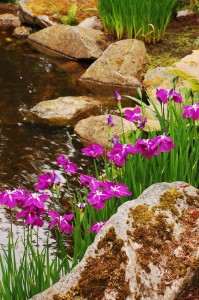 A walk in the woods looking for wildflowers might uncover more than spring and summer blossoms—it might uncover an old homestead. A row of irises blooming rather uniformly in the woods could indicate that an old wall used to be there and that a family once enjoyed the company of those irises cozied up next to their home over a century ago. Irises have been used by many a historian to map out old homes on what was once the frontier.
A walk in the woods looking for wildflowers might uncover more than spring and summer blossoms—it might uncover an old homestead. A row of irises blooming rather uniformly in the woods could indicate that an old wall used to be there and that a family once enjoyed the company of those irises cozied up next to their home over a century ago. Irises have been used by many a historian to map out old homes on what was once the frontier.
Today we enjoy irises alongside our house foundations and in our flowerbeds, too. While purple is a common iris hue, there are many different colors of iris available. They also can fill your yard with color throughout the early spring and through the mid-summer. From the first blooms of the dwarf irises to the last blooms of the dutch hybrids, you can enjoy irises for longer than just early spring. Some irises even re-bloom a few times throughout the growing season. With irises blooming year-round, a plant marker for iris blooms can help you anticipate those next blossoms of purple, yellow, pink or coral.
Irises come in many varieties including the following:
- Bearded Irises (Iris germanica and hybrids)
- Dutch hybrids (I. hollandica)
- Dwarf Irises (I. reticulata and I. danfordiae)
- Japanese Irises (I. ensata)
- Louisiana Irises (I. fulva, I. giganticaerulea and I. brevicaulis)
- Siberian Irises (I. siberica)
The strong erect stems of irises stand tall and steady in narrow or wide-necked vases. They provide large flowing blooms that will complement other arrangements of leafy or miniature flowers. Some irises are also very fragrant as well as showy.
If you notice over the years that your irises aren’t quite blooming the way they used to bloom, it may be time to separate them a bit. Different species of irises may perform better depending on how they are divided. While most irises are best divided and replanted in spring or fall, the bearded irises prefer to be divided just a few months after they’ve bloomed while it’s still hot outside. Cut the slender leaves back to about a third of their natural height and then separate the rhizomes.
When you divide your irises, it is also a good time to discard any rhizomes that are partially rotten or damaged by insect pests. Some of that damage could be due to the iris borer, an insect that leaves rhizomes mushy or punctuated with holes. Another sign of this lethal pest is that your iris leaves are streaked with yellow.
To avoid attracting the iris borer, be sure and clear away wet leafy debris from the base of the iris plants. Only a plant marker for iris blooms should be nestled up against the flat pointed leaves.
While irises can mark the sites of old homesteads, we can help mark your irises for the next generations. Our 100 percent stainless steel Kincaid Plant Markers will last through the season’s volatile moods, not fading and not rusting away. A plant marker for iris blooms will help you keep the history alive on your own home’s site.
